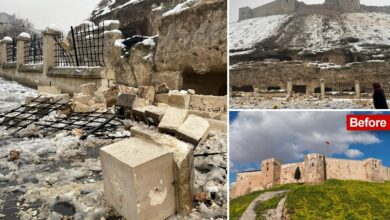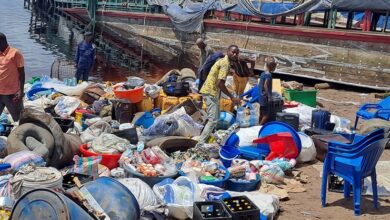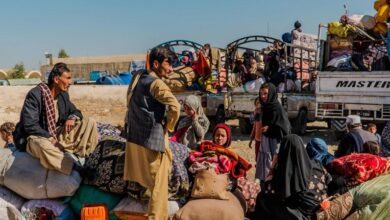40,000-Person Lost City In Pakistan

I looked about at the historic city as a faint wind cut through the sweltering heat. Millions of red bricks were laid in a grid-like pattern to create the streets, wells, and walkways. Overlooking the weathered streets was an ancient Buddhist stupa, and below it was a sizable communal pool with a broad staircase. I almost had the place to myself because there were so few other people around.
I was at the historical site of Mohenjo-Daro in southern Pakistan, approximately an hour’s drive from the dusty town of Larkana. 4,500 years ago, this location was not only one of the world’s earliest cities but also a thriving metropolis with highly developed infrastructures. Today, only ruins are visible.
The largest city of the formerly prosperous Indus Valley (also known as Harappan) Civilization, which ruled from north-eastern Afghanistan to north-western India during the Bronze Age, was Mohenjo-Daro, which means mound of the dead men in Sindhi. Mohenjo-Daro thrived from 2500 to 1700 BCE and is thought to have been home to at least 40,000 people.
But fewer people are aware of Mohenjo-Daro than the similarly thriving cities of Ancient Egypt and Mesopotamia. It was abandoned about 1700 BCE, and nobody knows for sure why or where the residents moved at this time.
The old city was initially discovered by archaeologists in 1911 after they learned that there was some brickwork nearby. The site remained untouched for a number of years after the Archaeological Survey of India (ASI) rejected the bricks as being of any age. R D Banerji, an ASI officer, didn’t think he observed a buried stupa—a mound-like structure where Buddhists traditionally meditate—until 1922. As a result, extensive excavations were conducted, most notably by British archaeologist Sir John Marshall and Mohenjo-Daro were eventually designated a Unesco World Heritage Site in 1980. Unknown levels of urbanization were revealed in the ruins they uncovered, and Mohenjo-Daro was hailed by Unesco as the best-preserved ruin in the Indus Valley.
The city’s superior sanitary system was perhaps its most unexpected characteristic. Although drainage systems and private latrines were present in Egypt and Mesopotamia, they were considered affluent people’s indulgences. There were hidden toilets and covered drains everywhere in Mohenjo-Daro. Since the start of the excavations, more than 700 wells as well as a network of personal baths, including a 12 m x 7 m Great Bath for communal use, have been found. Unbelievably, there were toilets in a lot of private homes, and a sophisticated sewage system served the entire city.
It has the level of complexity that we would expect from a modern city.
The people of Mohenjo-Daro were aware of their surroundings. Due to the city’s proximity to the Indus River to the west, they constructed remarkable platforms and drainage systems to protect themselves from yearly floods. They also played a significant role in a network of maritime trade routes that connected Central Asia and the Middle East. They produced intricately carved pottery, jewelry, figurines, and other items for centuries, and they were traded all over the world, from Mesopotamia to modern-day Oman.
The historic location is now a neighborhood park with picnic tables and lovely, shady plantings. However, it is uncommon for tourists from other parts of Pakistan to visit this isolated location. I strolled through the ancient streets that were laid out in a grid, taking in the numerous wells, the tall walls that provided much-needed shade, and the covered drains. I was amazed that all of this had been designed many centuries ago.
Not only were the people of Mohenjo-Daro skilled in sanitation and sewage disposal, but they also had other highly developed traits that distinguished them from other early civilizations. Despite a lack of machines, archaeologists have observed the use of standardized building materials.
The bricks, which were created by sun-drying and eventually being fired in a kiln, have withstood the elements for countless years. Rizvi clarified that while ostentatious architecture, such as mansions, temples, and other status symbols, are conspicuously absent from Mohenjo-Daro’s design, this does not imply that monumental architecture was nonexistent at the time.
I entered the Lower Town, which comprises the majority of Mohenjo-Daro’s 300+ hectares and is home to the city’s vibrant neighborhoods, by crossing a brick-lined sidewalk that went away from the Upper City. The organization was key in this situation. The numerous, relatively small streets were arranged in a deliberate grid with exact 90-degree angles. The thresholds used in the doorways of local homes, including those in bathrooms, are comparable to those in modern homes and buildings.
I learned more about these people at the Mohenjo-Daro Museum, a modest structure located in a grassy part of the compound. Numerous sculptures, pieces of jewelry, tools, toys, ornate seals, frequently featuring just one animal, and pottery have all been successfully removed from the site. The artifacts were astonishingly well-kept and were on display on rows of glass shelves.
A threshold indicates that someone has given consideration to what it means to be within and outside.
Two sculptures were among the artifacts: one depicted a young woman wearing jewelry and an elaborate hairstyle, and the other a well-groomed man with what looked like a high status.
However, a crucial fact that could reveal much more about the residents’ lives and times is still just out of grasp.
The residents of Mohenjo-Daro, who wrote in what is known as the Indus Valley Script, have not revealed any of their civilization’s secrets, despite the fact that ancient writings frequently do so. “It had more than 400 signs and was a pictographic language. It has not yet been decoded “said Solangi, my guide.
Another unsolved mystery is what specifically happened to Mohenjo-Daro.
Researchers are not entirely sure why the city was abandoned sometime around 1700 BCE, but it is generally accepted that climate factors were involved. Nevertheless, Mohenjo-Daro did not vanish instantly, according to Rizvi.
After deadly super floods struck Pakistan in August 2022, the metropolis is once again in jeopardy several thousand years later. While Mohenjo-Daro had been damaged, the flooding to the site was less than researchers had initially feared, according to Dr. Asma Ibrahim, an archaeologist, and museologist who has been involved in preservation work all over the country.
When asked about future protection measures for Mohenjo-Daro, Ibrahim suggested the use of channels to direct excess water away from the site but emphasized the need for a long-term strategy.
A long-term plan for the area will be advantageous to both the archaeological site and the numerous residents who live nearby, including Solangi. The stupa is clearly visible from Solangi’s house in Dandh village.
I concurred with Solangi’s depiction as I proceeded along the trails. I pictured the clean streets and precisely shaped bricks. the Great Bath, an underground pool. a widespread sanitation system that might function better than some of the current infrastructures in Pakistan.
And for a while at least, their investment was profitable. The people of Mohenjo-Daro enjoyed thriving conditions and living conditions that were above average for their period.
A few hours later, while I was riding back to Larkana in a clumsy autorickshaw, I couldn’t help but feel grateful. Mohenjo-Daro was submerged in sand and dirt for ages, seemingly lost forever in the plains of Interior Sindh.
However, one of the most advanced cities of the ancient world can now be visited once more because of the tireless efforts made over the past century by committed tour guides like Solangi and archaeologists. Additionally, you’ll frequently have the tidy, drain-lined streets to yourself.
News Mania Desk






